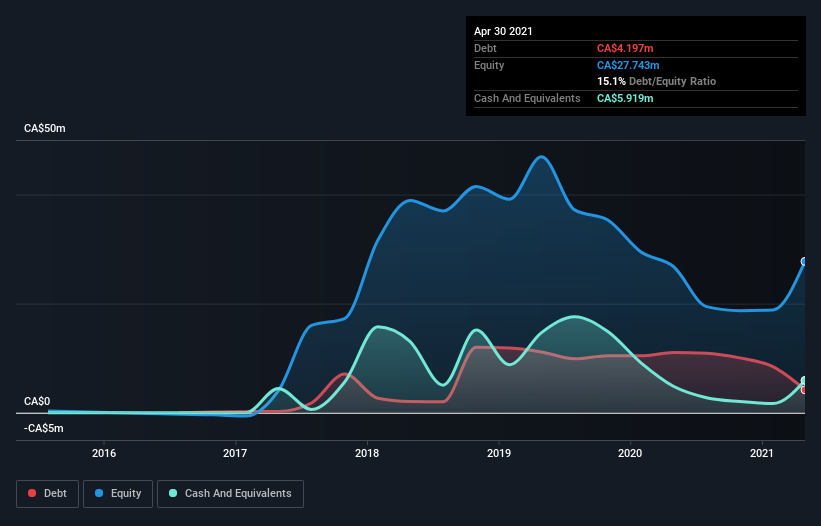Warren Buffett famously said, 'Volatility is far from synonymous with risk.' So it seems the smart money knows that debt - which is usually involved in bankruptcies - is a very important factor, when you assess how risky a company is. As with many other companies 1933 Industries Inc. (CSE:TGIF) makes use of debt. But the more important question is: how much risk is that debt creating?
When Is Debt A Problem?
Debt is a tool to help businesses grow, but if a business is incapable of paying off its lenders, then it exists at their mercy. In the worst case scenario, a company can go bankrupt if it cannot pay its creditors. However, a more frequent (but still costly) occurrence is where a company must issue shares at bargain-basement prices, permanently diluting shareholders, just to shore up its balance sheet. Of course, debt can be an important tool in businesses, particularly capital heavy businesses. The first step when considering a company's debt levels is to consider its cash and debt together.
See our latest analysis for 1933 Industries
What Is 1933 Industries's Net Debt?
As you can see below, 1933 Industries had CA$4.20m of debt at April 2021, down from CA$11.0m a year prior. However, it does have CA$5.92m in cash offsetting this, leading to net cash of CA$1.72m.

A Look At 1933 Industries' Liabilities
Zooming in on the latest balance sheet data, we can see that 1933 Industries had liabilities of CA$6.15m due within 12 months and liabilities of CA$13.1m due beyond that. On the other hand, it had cash of CA$5.92m and CA$1.15m worth of receivables due within a year. So it has liabilities totalling CA$12.2m more than its cash and near-term receivables, combined.
1933 Industries has a market capitalization of CA$33.8m, so it could very likely raise cash to ameliorate its balance sheet, if the need arose. However, it is still worthwhile taking a close look at its ability to pay off debt. Despite its noteworthy liabilities, 1933 Industries boasts net cash, so it's fair to say it does not have a heavy debt load! The balance sheet is clearly the area to focus on when you are analysing debt. But you can't view debt in total isolation; since 1933 Industries will need earnings to service that debt. So when considering debt, it's definitely worth looking at the earnings trend. Click here for an interactive snapshot.
In the last year 1933 Industries had a loss before interest and tax, and actually shrunk its revenue by 20%, to CA$12m. That makes us nervous, to say the least.
So How Risky Is 1933 Industries?
By their very nature companies that are losing money are more risky than those with a long history of profitability. And the fact is that over the last twelve months 1933 Industries lost money at the earnings before interest and tax (EBIT) line. Indeed, in that time it burnt through CA$4.8m of cash and made a loss of CA$8.5m. Given it only has net cash of CA$1.72m, the company may need to raise more capital if it doesn't reach break-even soon. Overall, we'd say the stock is a bit risky, and we're usually very cautious until we see positive free cash flow. When analysing debt levels, the balance sheet is the obvious place to start. But ultimately, every company can contain risks that exist outside of the balance sheet. For instance, we've identified 5 warning signs for 1933 Industries (2 are concerning) you should be aware of.
If, after all that, you're more interested in a fast growing company with a rock-solid balance sheet, then check out our list of net cash growth stocks without delay.
New: AI Stock Screener & Alerts
Our new AI Stock Screener scans the market every day to uncover opportunities.
• Dividend Powerhouses (3%+ Yield)
• Undervalued Small Caps with Insider Buying
• High growth Tech and AI Companies
Or build your own from over 50 metrics.
This article by Simply Wall St is general in nature. We provide commentary based on historical data and analyst forecasts only using an unbiased methodology and our articles are not intended to be financial advice. It does not constitute a recommendation to buy or sell any stock, and does not take account of your objectives, or your financial situation. We aim to bring you long-term focused analysis driven by fundamental data. Note that our analysis may not factor in the latest price-sensitive company announcements or qualitative material. Simply Wall St has no position in any stocks mentioned.
Have feedback on this article? Concerned about the content? Get in touch with us directly. Alternatively, email editorial-team (at) simplywallst.com.
About CNSX:TGIF
1933 Industries
Engages in the cultivation, extraction, and production of cannabis products in the United States.
Fair value with low risk.
Similar Companies
Market Insights
Community Narratives



